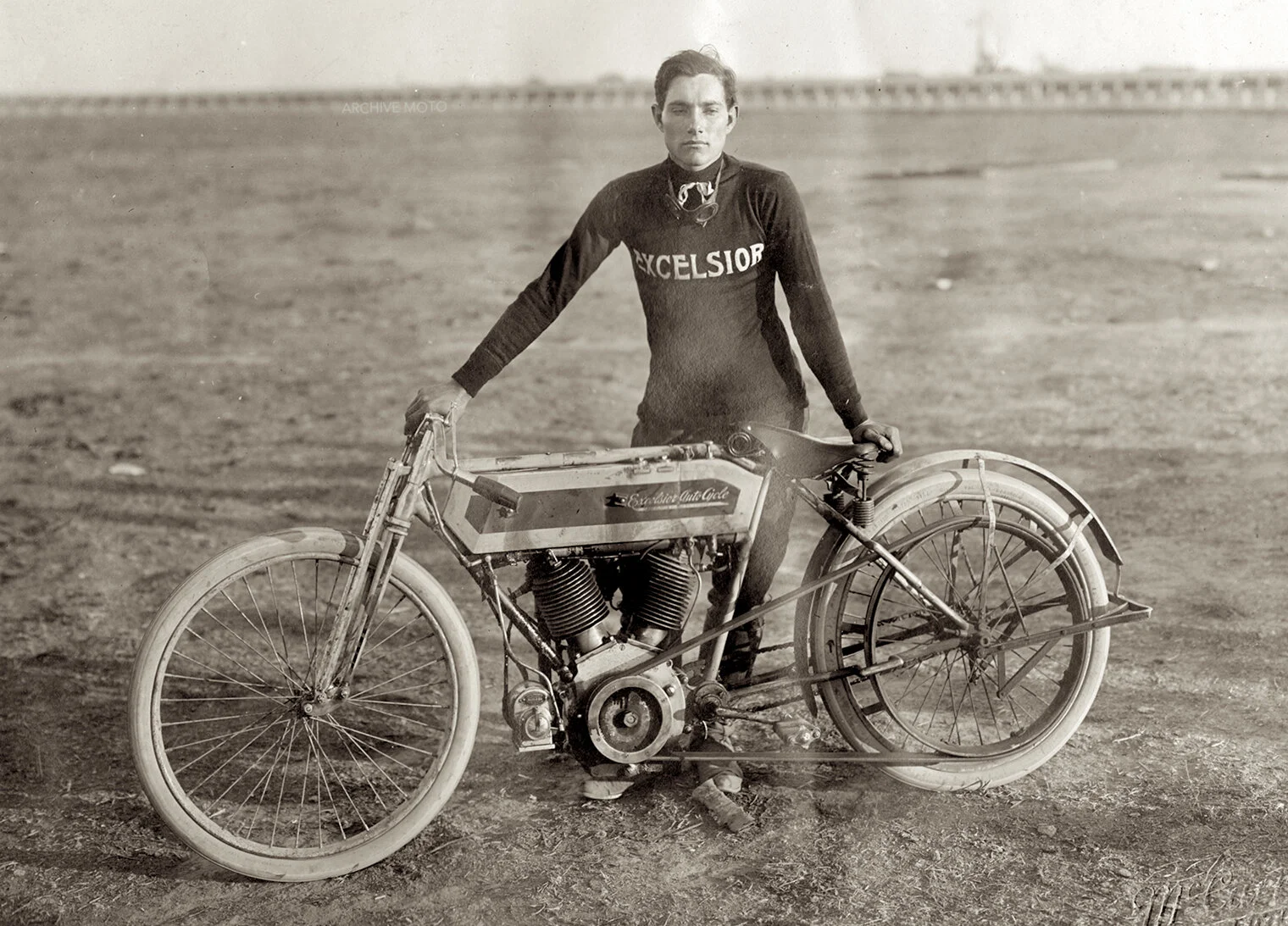Elvin Austin Shoemaker, an amateur trade rider posing with his stripped-stock 1911 Excelsior Auto-Cycle Model G at Agriculture Park in Sacramento California, October 21st, 1911.
Elvin Austin Shoemaker, an amateur trade rider from Sacramento, California, posing with his race-configured 1911 Excelsior Auto-Cycle Model G. The 19-year-old Shoemaker was a sales clerk at the Sacramento Excelsior dealership, William A. Langley's capital for all things motorcycle in Northern California at the time. The young clerk had just won the Sacramento Motorcycle Club's 5-mile championship race at Agriculture Park on October 21st, 1911. Shoemaker jockeyed his stripped-stock Excelsior twin around the dusty trotting track at an average speed of 55 mph, taking the amateur championship prize as well as a third-place finish in the stock twin race. His mount was the latest release from the Excelsior Supply Company, their first twin-cylinder offering, and their last machine under the companies founding owners. A deal was struck only days before, handing over the fledgling Excelsior brand to bicycle magnate Ignaz Schwinn, a steal at only $500,000.
Schwinn wouldn't take official control of Excelsior until February 1912, but his plans for revamping the brand had already begun. Excelsior maintained a presence on the track since it began production in 1908. Still, Schwinn saw an opportunity to further invest in a factory racing program, and the timing couldn't have been better. Pioneer track star "Farmer" Joe Wolters had been instrumental to the factory program throughout 1911, playing a large part in developing the big valve Series 7, a chain-driven, ported 61 c.i. twin-cylinder beast. Adding to the building momentum in the Excelsior competition camp was the recent addition of two of the biggest names in motorcycle racing, Jacob DeRosier, and Charlie "Fearless" Balke. They were recruited away from the Springfield WigWam at Indian just weeks before the races in Sacramento. In the last days of 1911, Excelsior had a powerful stable of riders and a capable and proven new track machine with the Series 7. With Schwinn's investment Excelsior would soon become a top contender in the sport and earn a spot among the Big 3 American motorcycle manufacturers at the start of the 20th century.
Just an amateur trade rider, Shoemaker's machine was not one of the factory specials but a modified stock twin off of the showroom floor. The Model G was a belt-driven 50 c.i. F-head twin nestled into Excelsiors keystone frame. A pricey ride at $310 in those days, this motorcycle was most likely owned by Shoemaker's boss, local dealer, and avid motorcycling enthusiast William A. Langley. Besides being one of the first Excelsior dealers upon the companies' first year of production, Langley's dealership supplied the region with machines from Henderson, Pope, Jefferson, and Thor. Considered one of the most enthusiastic motorcyclists in the area, Langley ran an active dealership, competing in events and organizing endurance runs, tours, and races in conjunction with the local clubs. Shoemaker's dealership racer had the belt tensioner and eclipse clutch lever assemblies removed and a larger belt-drive hub installed. Also gone were the front fender, the under-saddle toolbox, and muffler. The cumbersome stock handlebars were replaced with a nice set of what appear to be nickel-plated drop bars, compete with both timing advance and throttle linkages in place. These dealer modified machines were often classified as stripped-stock and made for the most nimble and quick stock machines that competition rules would allow.
The week's worth of races at Sacramento's Agriculture Park were staged as national riders began their pilgrimage back to Northern California to finish the season in Oakland. It was there that Jack Prince had recently completed his newest board track motordrome at Elmhurst. As a result, many of America's fastest men were on hand to make a run for the money in Sacramento the weekend of October 20th, including Ray Seymour, George Collins, Johnny Seymour, local hero Hap Alzina. Excelsior factory stars Joe Wolters, and Erle "Red" Armstrong were scheduled to compete in Sacramento that weekend but had been held up on their train ride from Denver. The newest recruit to the Excelsior factory team, Charlie Balke, had arrived on time to compete, but his factory Series 7 had also been delayed on the train ride over, causing him to miss the first few days of races. Balke had just set a new 1-mile world record on the fairground track in Birmingham, Alabama, a just the week before. He reportedly boasted that as soon as his bike showed up, he could easily run a mile in under 50 seconds, given that the Sacramento track was in much better shape than the one in Birmingham. Once Balke's big valve Excelsior arrived, he backed up his bluster by lowering the track record in Sacramento and winning every event he entered before heading to Oakland.
The Fall of 1911 would mark record speeds, the majority at the Excelsior team's hand, with new top marks consistently reaching over 80 mph. Young Elvin Shoemaker came close to a mile a minute that day but never pursued a life as a professional rider; he married in 1914 and had three children with his wife, Averil. Shoemaker spent the remainder of his days working as a wrench in ship and train yards before opening his own service station, where he worked until his death in 1967. Elvin Shoemaker was one of the countless pioneer enthusiasts, an everyman racer and club rider, but back in the autumn of 1911, he rubbed elbows with legends, he ran with the fastest men on Earth, and he had a medal to prove it.


